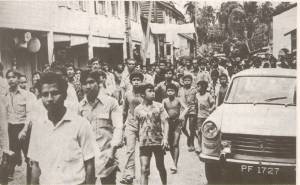BALING
1974! MALAYSIA'S EMERGING RURAL REVOLUTION
Denzil
Peiris
He had heard, too, of three or four deaths of people who had eaten poisonous jungle yams. According to one Government doctor, mothers in some parts of Malaysia no longer breast-feed their children but give them powdered milk.
Now, however, they are diluting the powdered milk because it has doubled in cost. The result has been increasing malnutrition among infants.
 Awang
also cannot understand why he should have had to exchange more than two
catties of rubber for a single catty of rice, which accounts for 50% of
a peasant family's total expenditure.
Awang
also cannot understand why he should have had to exchange more than two
catties of rubber for a single catty of rice, which accounts for 50% of
a peasant family's total expenditure.
And in November last year, it rained frequently and Awang had no latex to sell. The explosion came in mid-November in the Baling district.
Awang will not say whether he joined them or not, but peasants did join protest marches against deteriorating conditions. The biggest of these demonstrations was on November 21 when about 12;000 peasants took to the streets.
It was the first time in 28 years that peasants had marched. Previously, they had joined the massive popular opposition to the British proposa.l for a Malayan Union in 1946.
"Hunger marches" are so frequent in India and South Asia that, like the callouses on peasants' feet, they are ignored. The Malaysian authorities are not used to people "voting with their feet."
Tear-gas was fired into the crowd on November 21. The word reached the several university carnpuses in Malaysia, although the newspapers were either ignorant of the protests, or had been told to black out their reports.
The next stage in the "Baling explosion" was the eruption in the universities, first on the padang (open space) in Kuala Lumpur, then on the campuses in the capital and among students in some of the technical, agricultural and other universities elsewhere.
All of these were demonstrations of sympathy and support for the undeniable social distress in Baling. One of the leaflets distributed by some university students not only analysed the "Baling issue," but also referred to "the imperialists' plunder of our natural resources and exploitation of our workers and peasants."
The leaflet alleged that "from 1967 to 1971, the total capital outflow amounted to S3,017 million three times the total public expenditure of $1,007 million in the First Malaya Plan."
They claimed that in 1969 alone, "British imperialists looted our country of $2.2 million." The leaflet asked the Government, "in view of such unprecedented plunder, why do you go all out to invite foreign `investment' with such benefits as exploitation of our workers, peasants, tax holidays, etc?"

